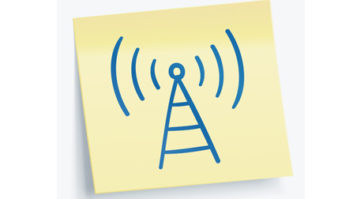The demand for community and neighborhood broadcasting will not be fully accommodated in the existing AM and FM broadcasting bands. These frequency bands are too crowded in the urban areas of the United States.
Thus it will be necessary to look for new frequencies for local broadcasting. The most promising frequency range is the millimeter-wave frequencies (30 to 300 GHz).
This lightly-used band of frequencies has a huge capacity to accommodate communications including numerous local radio broadcasting stations.
Millimeter-wave transmitters now in use tend to be low in power, fed to very high-gain antennas. This communication often is referred to as “pencil beam” communication but it is not a natural match for the omnidirectional transmissions used by broadcasters.
However, a pencil beam can be converted into an omnidirectional broadcasting system by using a rotating beam. The high-gain transmitting antenna is mounted so that it can be continuously rotated in a similar manner to a plan position indicator (PPI) radar antenna.
The transmitting millimeter wave beam would “paint” the surrounding geographic area like an electronic lighthouse.
Lighthouse protocol
The neighborhood broadcasting station would transmit packets of digital program material to the broadcast receivers. Each receiver would store the packets and play the program material to the listener.
The station would use a protocol where the same set of packets would be repeated for each beam-width around the points of the compass.

Fig. 1: If the transmitting antenna has a 10-degree beam-width, it would transmit 36 repetitions of the packet set.
For example, if the transmitting antenna has a 10-degree beam-width, it would transmit 36 repetitions of the packet set. Each repetition would be at a different compass direction to cover a full 360 degrees (see Fig. 1).
The radio receivers would put the packets together and play them out to the listeners. This would result in the program material being delayed somewhat from real time; but this would not be a major problem for most neighborhood broadcasting applications.
Neighborhood broadcasting
A frequency range in the vicinity of 60 GHz is desirable because the atmosphere strongly absorbs these transmitted signals. This will limit each broadcaster to a single neighborhood or modest-sized community. The same channels can then be reused in a nearby community with no problem of interference. This absorption of the signals is strong enough that you could have several reuses of a 1,000-channel set within a single metropolitan area such as the New York City area.
Here at last you have a neighborhood broadcasting system that can be used in dense urban areas. This is a contrast to the existing low-power FM (LPFM) broadcasting service, which has been limited largely to rural areas by spectrum crowding concerns.
Propagation issues
Of course this new technology will have some technical and developmental challenges, such as propagation.
Millimeter-wave transmissions are very much a line-of-sight process, like light-wave transmission. Leaves of trees can absorb the signals. As a result, outdoor receiving antennas above the roof line would be desirable for this radio service. This could conflict with the widespread prohibitions of external antennas by homeowner associations and condominiums.
Any FCC docket on millimeter-wave broadcasting would have to address these private regulations and their negative impact on this new broadcasting opportunity.
Additional spectrum
If the millimeter waves do not provide enough spectrum, even higher frequencies can be used, such as infrared light.
As we go higher in frequency, the available capacity increases; we can create a situation where there is no shortage of frequencies available for this type of broadcasting.
This is a stark contrast to the situation on the traditional AM, FM and shortwave broadcast bands. In a light-wave version of lighthouse broadcasting, a low-power laser would serve as the transmitter and a focusing mirror with a light detector would serve as the receiver. Standards would be established regulating the power of the laser to reliably safe levels somewhere under five milliwatts of output power.
Developing the idea
At this point in time, lighthouse protocol broadcasting needs additional development before it is ready for commercial use. In this difficult economy, there are not a lot of development funds available. This can be overcome by using volunteer labor. Amateur radio operators have built and operated radio communications equipment up to 400 GHz. The amateur radio community can be recruited to develop and test lighthouse communications, as I wrote in the 2004 article “A ‘Lighthouse’ Protocol for Random Microwave Contacts,” published in the ARRL’s “QEX: A Forum for Communications Experimenters.”
In addition, university engineering departments and graduate students can be involved in the development of lighthouse protocol broadcasting. Rapid progress can be made because the protocol allows existing low-power millimeter wave transmitters to be used for the initial experimental tests. Some graduate degree theses can be devoted to different aspects of the development.
Nickolaus Leggett is an electronics technician, analyst, technical writer and inventor. He holds three U.S. patents. He was one of the original petitioners for the low-power FM radio broadcasting service.












